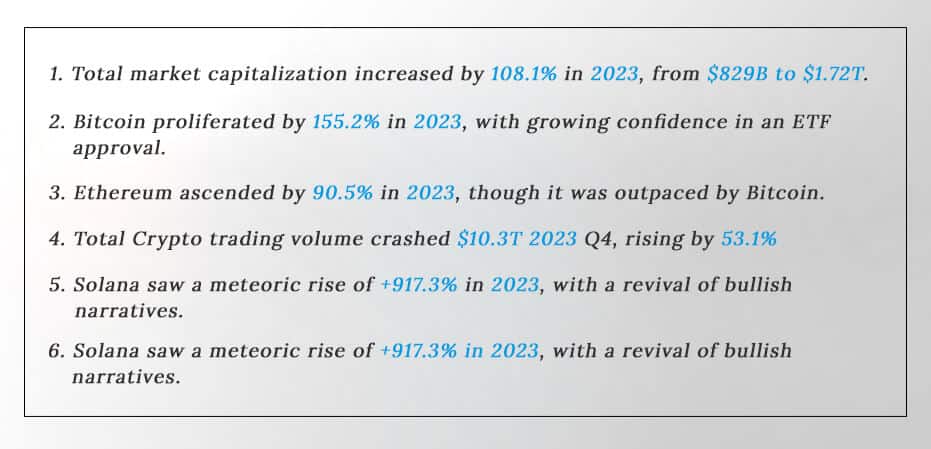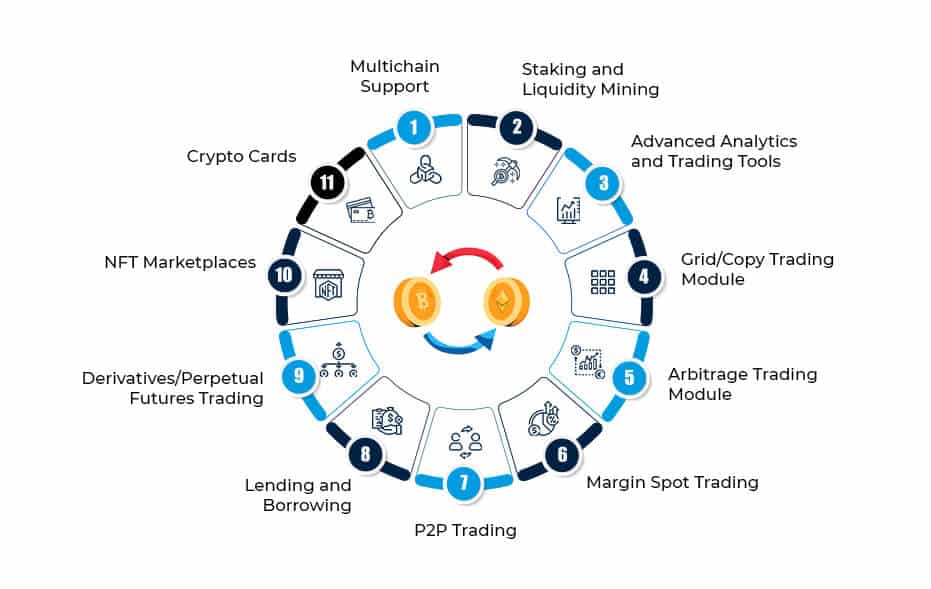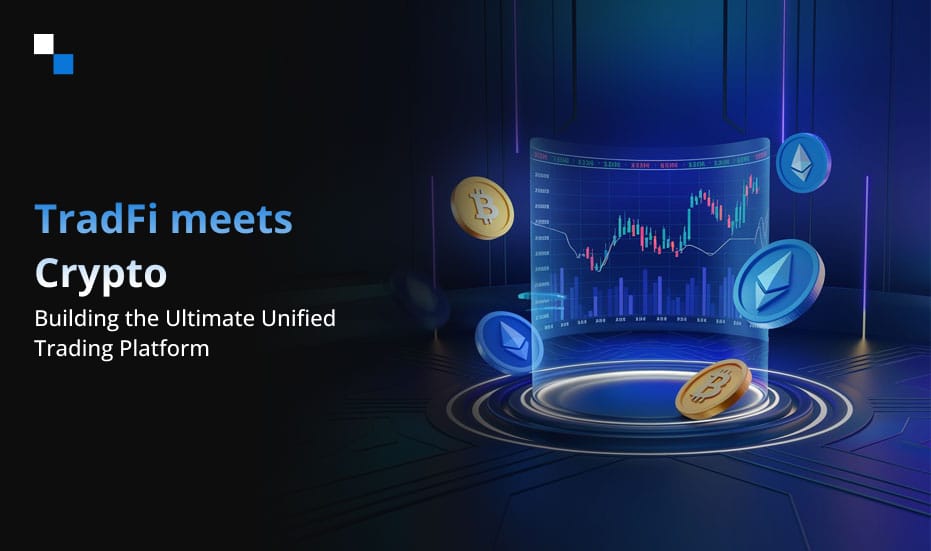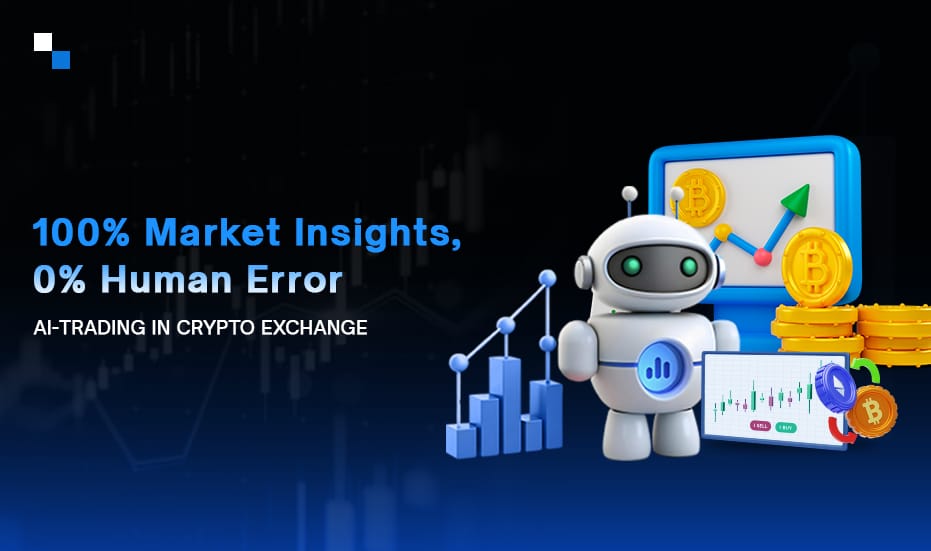
How Can the Metaverse Platform for Education Transform Soft Skills Training?
July 16, 2024
Make Seamless Utility Bill Payments Using White Label Crypto Wallet
July 17, 2024- Introduction
- Market Overview
- Top Features for Thriving Exchange App Development in 2024
- Turning Your Vision Into Reality in 5 Steps: Your Exchange Software Development Roadmap
- Top 5 Exchange Development Company Considerations For Your Project
- How much does exchange platform development cost?
- Getting Started ASAP
Introduction
The cryptocurrency market is a dynamic landscape and there is no space for stagnant businesses. To keep up with the constantly evolving needs of customers and stay relevant in the competitive cryptoscape, exchange apps need to be upgraded continuously.
A standout strategic approach during cryptocurrency exchange app development is therefore necessary for businesses planning to gallop a huge part of the overall crypto market pie. Because, guess what? Everyone’s in the queue, battling for it – established businesses in the crypto exchange industry, newcomers, and upcoming projects too.
So, with user demands and preferences shifting rapidly and competition matching the pace, what features should you be including in Exchange Platform Development to make it outpace others?
Before discussing those features, let’s take a look at how promising this opportunity of launching an exchange can be for cryptopreneurs.
Market Overview
In terms of market growth, the cryptocurrency market has exploded recently. Without much ado, let’s have a look at those numbers from 2023 by popular market intelligence, demonstrating the potential of Exchange Software Development in 2024.

Source: Coingecko
There’s no denying that 2024 has done a lot better. Whether we talk about the 68.8% Bitcoin growth or the overall ecosystem expansion of Solana, the market performance was phenomenal in the first quarter itself. Spot crypto ETFs, regulatory clarity, full implementation of Ethereum 2.0, layer 2 innovations, increased user base, bitcoin halving, and the development of established infrastructure were some of the factors driving the growth. The profitability of exchange app development is therefore on the rise.
It’s time to discuss the features that will propel your exchange business growth in 2024.
Top Features for Thriving Exchange App Development in 2024
The cryptocurrency trading infrastructure has evolved significantly and matured to a great extent, which means there are a lot of features that have become essential, while many innovative ones are distinguishing top exchanges.
Essential Features For Exchange Platform Development
Basic features lay the groundwork for successful exchange software development in 2024 and beyond. Here’s a list of those basic features that an exchange can never miss.
- Unbreakable Security
- Automated KYC/AML Compliance
- User-Friendly Interface
- Competitive Fees
- High TPS (Transaction Per Second) and Advanced Matching Engine
- Enterprise-Grade Multi-cryptocurrency Wallet
- External Liquidity Module
- Unwavering Customer Support
- Spot Trading
- Advanced Order Types
- Referral and Reward Program
- Fiat On/Off Ramp
- News and Announcements
- Crypto Swapping
- Advanced Admin Back Office
- Mobile Application

Your Crypto Exchange Website Development Company may just touch the base of these essentials but might not provide full-fledged or innovative solutions for the basic needs of exchange. But to succeed, you have to integrate the features as per the highest market standards, as that is only the key to success in the dynamic crypto exchange market.
Top 10 Exchange Software Development Features That Will Make An Impact in 2024 and Beyond
Now, let’s cover some intermediate and advanced exchange platform development features that can help exchanges get a competitive edge:
1. Multichain Support:
The days of single-chain supremacy are long gone. It’s time to embrace the blockchain multiverse. Users are increasingly seeking platforms that cater to the diverse functionalities offered by various blockchains. Integrate support for multiple blockchains (e.g., Ethereum, Solana, and Avalanche) during your exchange software development to attract a wider audience and broaden your user base.
2. Staking and Liquidity Mining
Make your exchange a self-regulated entity by empowering users to contribute to the platform’s liquidity and stability by offering staking and liquidity mining incentives. With staking, users lock their funds with your platform for a set period, while in liquidity mining, they provide liquidity for specific trading pairs. Integrating both of these modules during exchange app development secures users’ interest for a longer period and offers liquidity and stability to your exchange.
3. Advanced Analytics and Trading Tools
Want huge institutional investors to approach your exchange so that you can reap enormous profits? If so, attract serious traders by integrating advanced analytics and trading tools during your exchange platform development. Offering a variety of charting tools for technical analysis allows users to identify trends and make informed trading decisions. Similarly, technical indicators and real-time market data analysis access can enhance user activity on your trading platforms.
4. Grid/Copy Trading Modules:
Enable customers to capitalize on market trends with a smart grid trading bot that incorporates technical indicators and dynamic grid adjustments. Integrating these features during exchange software development fosters user engagement and informed decision-making. Social copy trading with reputational scores also enables traders to copy successful traders based on verifiable performance metrics and community reputation.
5. Arbitrage Trading Module:
Let your customers unlock access to unhindered passive income with a cross-exchange arbitrage automation module that scans markets and executes trades itself. You can also step ahead and include a fail-safe flash loan arbitrage tool during exchange app development that performs complex arbitrage strategies with ease and maximizes profits for you and your customers.

6. Margin Spot Module:
Enhance gains and risks for your customers with a sophisticated margin trading module housing flexible margin options, auto-deleveraging stop-loss integration, etc. Tiered margin ratios cater to different risk appetites, whereas automated risk management tools like those mentioned earlier minimize potential losses for traders in volatile crypto markets.
7. P2P Exchange, Lending and Borrowing:
Integrating these features makes your exchange software development worth your attention. There’s a huge trader base advocating trustless environments for trading, lending, etc. Simple P2P trading and an advanced lending module with diverse loan terms, interest rates, collateral options, etc. can enhance your platform’s credibility. Automated staking and yield optimization tools can also be integrated into your exchange app development plan.
8. Derivatives/Perpetual Futures Trading:
Focus on serving the maximum trader base by integrating as many trading modules as possible. You can support advanced order types, like trailing stops and basis trading for sophisticated derivatives traders. Dedicated market analysis tools specifically tailored for derivatives markets also empower informed trading decisions and enhance the prospects of success for your exchange platform development project.
9. NFT Marketplaces:
An all-encompassing experience makes users glued to your platform. The colossal success stories of Binance, Coinbase, and other prominent NFT marketplace-integrated exchanges are footsteps to follow for your success in the crypto domain. Given the profitability of NFT marketplaces, many existing and new exchanges are coming up with exchange app development plans. Fractional NFT ownership and curated NFT collections are all over the crypto space nowadays.
10. Crypto Cards:
Empower your customers to spend their crypto anywhere with seamless crypto-to-fiat conversion on prepaid crypto cards that mirror the functionality of conventional debit cards issued by banks. Leading crypto exchanges like Binance, Coinbase, and Crypto.com are already offering crypto cards to their customers and many other existing and new players are planning this integration.

Want to learn about more features? Here’s our blog that highlights a wide array of features for your exchange software development.
Other Considerations:
1. Unique Selling Proposition (USP):
What makes your exchange app different from existing ones? Don’t just implement it but say it out loud with effective marketing measures. Do your market research comprehensively, identify your USP, and highlight it in your marketing and exchange app development strategy.
2. Prioritize Security:
Security breaches can erode users’ trust in your platform. Invest in robust security measures and conduct regular security audits to ensure your audiences never have to worry about their fund security or private information leaks. This is the first step towards optimizing user experiences.
3. Stay Updated on Trends:
Find an exchange development company that helps you remain future-proof with their innovative solutions. The crypto landscape is constantly evolving and there’s cutthroat competition to surpass in order to gain some attention. It’s better to stay informed about emerging trends (e.g., DeFi, NFTs, layer 2 integrations, data stream integration, etc.) and adapt your exchange app development and upgrades accordingly.
4. Layer 2 Integration:
Layer 2 solutions offer scalability and lower transaction fees, making them an essential consideration for modern exchanges. They have recently proven to be game-changers for various exchange businesses such as dYdX, Loopring, Immutable X, Uniswap V3, SushiSwap V2, etc.
5. Active Community Building
Go beyond the exchange software development and focus on community. Building a thriving community around your exchange app is essential for long-term success. Regular communication, an active social media presence, comprehensive educational resources, community reward and recognition, events and AMAs, incentivizing user feedback, etc. are some strategies that can be leveraged to maintain an active community.
Turning Your Vision Into Reality in 5 Steps: Your Exchange Software Development Roadmap
Now that you know what features to include in your exchange software development checklist, it’s time to take you through the steps in the development process.
Let’s dig into it…
Planning and Design:
- Define Your Target Audience: Who are you building this app for? Understanding your target user base will guide your feature selection and overall design approach during exchange app development.
- Feature Prioritization: Not all features can be implemented at once. Prioritize the essential features and functionalities based on your target audience and budget so your budget and time are optimally utilized.
- Regulatory Landscape: Cryptocurrency regulations are constantly evolving, so staying compliant is crucial. Research and understand the regulatory landscape in your target markets and if necessary, partner with a leading Crypto Exchange Website Development Company.
Consider Development Approaches:
- White Label Solutions: These pre-built exchange platforms can save time and resources but might limit customization options. It’s not suitable for businesses planning to build an advanced exchange. However, a scalable white label exchange such as the one offered by Antier opens the door for innovation and possibilities in the future if a business’ budget doesn’t allow it initially.
- Building from scratch: This exchange software development approach offers maximum flexibility for customization but requires a highly skilled development team and significant resources. When you partner with a reliable exchange development partner, it is the best solution to go with as it accommodates as many features and completely bespoke UI/UX experiences.
Testing and Deployment:
- Thorough Security Audits: Conduct rigorous security audits by engaging a reputable crypto exchange website development company to identify and address potential vulnerabilities before launch. You can also directly partner with a smart contract audit firm but if you’re new to the industry, your development partner can help you shake hands with reliable players in the smart contract security space.
- Testing on a Testnet Before Mainnet Launch: Join forces with your exchange development company to deploy your app in a testnet environment for user testing and feedback. Gather user insights and iterate on your design to ensure a smooth user experience. Once you’re confident in your app’s security and functionality, launch it on the mainnet of your chosen blockchain network.
Compliance and Marketing:
- Stay Updated on Regulations: The regulatory frameworks surrounding cryptocurrency exchanges are constantly evolving. Stay informed, ensure your app complies with relevant regulations, and exchange software development trends. You can seek legal consulting from a lawyer specializing in blockchain and cryptocurrency regulations.
- Develop a Marketing Strategy: Craft a comprehensive marketing strategy to attract users and build a strong community around your exchange app. Utilize various channels like social media, content marketing, and influencer marketing. It is recommended to implement user acquisition strategies like referral programs and targeted advertising to attract new users to your platform.
Top 5 Exchange Development Company Considerations For Your Project
Here are some of the leading development companies specializing in secure and user-friendly exchange software development.
- Antier: Renowned for their innovative, industry-grade, secure and scalable white label and custom exchange software development solutions with advanced features.
- Blockchain App Factory: Focuses on secure and user-friendly exchange apps with customizable white label solutions.
- ChainSwap: Offers user-friendly white label exchange solutions with built-in liquidity aggregation and staking functionalities.
- Moralis: Provides a comprehensive Web3 development platform, including white label DEX solutions with robust APIs.
- CoinFactory: Caters to businesses on a budget with cost-effective white label exchange solutions and quick deployment options.
How much does exchange platform development cost?
Anywhere from $40,000 to $3,50,000. It’s a rough estimate and your requirements quote the price. Here are some factors that affect the exchange software development cost quite significantly:
- Project Scope and Complexity
- Development Team Location
- Development Approach
- Security Features
- Trading Features
- Mobile App Development

Getting Started ASAP
If you haven’t yet discussed your plan with the best Crypto Exchange Website Development Company, you are already late. Don’t let this delay stop you from making lucrative profits. Pick the right development partner, as it is crucial for the success of your exchange app, and do your research to get clarity on what you want. The next step is to approach your Exchange Development Company with clear requirements and expectations. It saves time for you both.
What else?
Let’s not worry about that. At Antier, we offer end-to-end exchange app development services so our customers don’t have to pull harder on the development side. We take care of the technology and extend your partnerships with the best legal experts and marketing professionals. So, everything else is taken care of when you choose us for your exchange software development.
Begin your exchange platform development with us; share your requirements right away!



